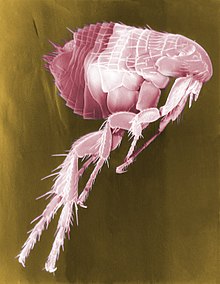| Fleas Temporal range:
| |
|---|---|

| |
| Scanning electron micrograph | |
| Scientific classification | |
| Domain: | Eukaryota |
| Kingdom: | Animalia |
| Phylum: | Arthropoda |
| Class: | Insecta |
| Clade: | Aparaglossata |
| Superorder: | Panorpida |
| (unranked): | Antliophora |
| Order: | Siphonaptera Latreille, 1825 |
| Suborders | |
| |
| Synonyms | |
|
Aphaniptera | |
Flea, the common name for the order Siphonaptera, includes 2,500 species of small flightless insects that live as external parasites of mammals and birds. Fleas live by ingesting the blood of their hosts. Adult fleas grow to about 3 millimetres (1⁄8 inch) long, are usually brown, and have bodies that are "flattened" sideways or narrow, enabling them to move through their hosts' fur or feathers. They lack wings; their hind legs are extremely well adapted for jumping. Their claws keep them from being dislodged, and their mouthparts are adapted for piercing skin and sucking blood. Some species can leap 50 times their body length, a feat second only to jumps made by another group of insects, the superfamily of froghoppers. Flea larvae are worm-like, with no limbs; they have chewing mouthparts and feed on organic debris left on their hosts' skin.
Genetic evidence indicates that fleas are a specialised lineage of parasitic scorpionflies (Mecoptera) sensu lato, most closely related to the family Nannochoristidae. The earliest known fleas lived in the Middle Jurassic; modern-looking forms appeared in the Cenozoic. Fleas probably originated on mammals first and expanded their reach to birds. Each species of flea specializes, more or less, on one species of host: many species of flea never breed on any other host; some are less selective. Some families of fleas are exclusive to a single host group; for example, the Malacopsyllidae are found only on armadillos, the Ischnopsyllidae only on bats, and the Chimaeropsyllidae only on elephant shrews.
The oriental rat flea, Xenopsylla cheopis, is a vector of Yersinia pestis, the bacterium that causes bubonic plague. The disease was spread to humans by rodents, such as the black rat, which were bitten by infected fleas. Major outbreaks included the Plague of Justinian, about 540, and the Black Death, about 1350, each of which killed a sizeable fraction of the world's people.
Fleas appear in human culture in such diverse forms as flea circuses; poems, such as John Donne's erotic "The Flea"; works of music, such as those by Modest Mussorgsky; and a film by Charlie Chaplin.